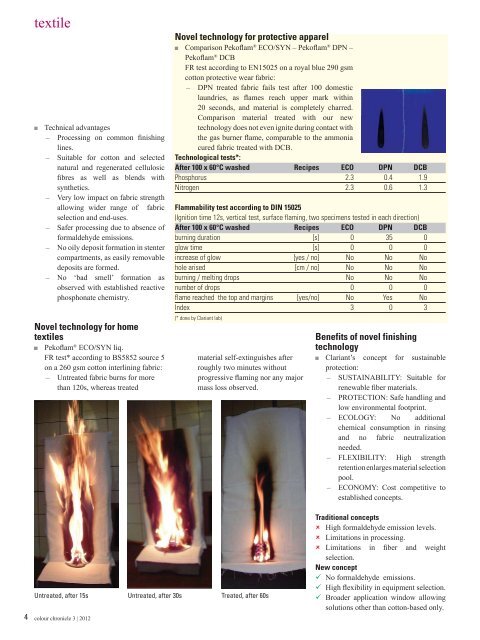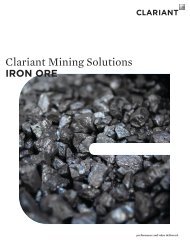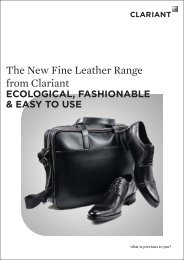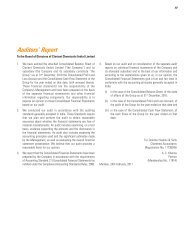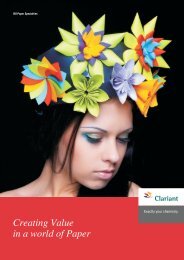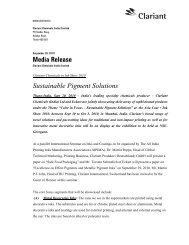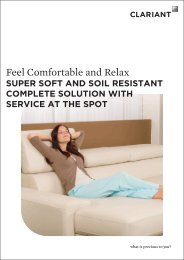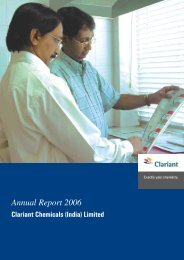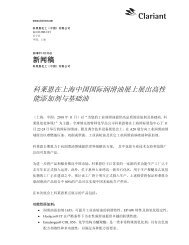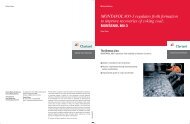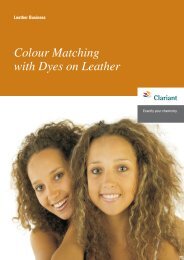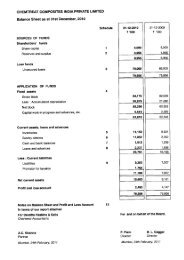Colour Chronicle - Sept 2012 - Clariant
Colour Chronicle - Sept 2012 - Clariant
Colour Chronicle - Sept 2012 - Clariant
You also want an ePaper? Increase the reach of your titles
YUMPU automatically turns print PDFs into web optimized ePapers that Google loves.
textile<br />
Technical advantages<br />
– Processing on common finishing<br />
lines.<br />
– Suitable for cotton and selected<br />
natural and regenerated cellulosic<br />
fibres as well as blends with<br />
synthetics.<br />
– Very low impact on fabric strength<br />
allowing wider range of fabric<br />
selection and end-uses.<br />
– Safer processing due to absence of<br />
formaldehyde emissions.<br />
– No oily deposit formation in stenter<br />
compartments, as easily removable<br />
deposits are formed.<br />
– No ‘bad smell’ formation as<br />
observed with established reactive<br />
phosphonate chemistry.<br />
Novel technology for home<br />
textiles<br />
Pekoflam ® ECO/SYN liq.<br />
FR test* according to BS5852 source 5<br />
on a 260 gsm cotton interlining fabric:<br />
– Untreated fabric burns for more<br />
than 120s, whereas treated<br />
Novel technology for protective apparel<br />
Comparison Pekoflam ® ECO/SYN – Pekoflam ® DPN –<br />
Pekoflam ® DCB<br />
FR test according to EN15025 on a royal blue 290 gsm<br />
cotton protective wear fabric:<br />
– DPN treated fabric fails test after 100 domestic<br />
laundries, as flames reach upper mark within<br />
20 seconds, and material is completely charred.<br />
Comparison material treated with our new<br />
technology does not even ignite during contact with<br />
the gas burner flame, comparable to the ammonia<br />
cured fabric treated with DCB.<br />
Technological tests*:<br />
After 100 x 60°C washed Recipes ECO DPN DCB<br />
Phosphorus 2.3 0.4 1.9<br />
Nitrogen 2.3 0.6 1.3<br />
Flammability test according to DIN 15025<br />
(Ignition time 12s, vertical test, surface flaming, two specimens tested in each direction)<br />
After 100 x 60°C washed Recipes ECO DPN DCB<br />
burning duration [s] 0 35 0<br />
glow time [s] 0 0 0<br />
increase of glow [yes / no] No No No<br />
hole arised [cm / no] No No No<br />
burning / melting drops No No No<br />
number of drops 0 0 0<br />
flame reached the top and margins [yes/no] No Yes No<br />
Index 3 0 3<br />
(* done by <strong>Clariant</strong> lab)<br />
material self-extinguishes after<br />
roughly two minutes without<br />
progressive flaming nor any major<br />
mass loss observed.<br />
Benefits of novel finishing<br />
technology<br />
<strong>Clariant</strong>’s concept for sustainable<br />
protection:<br />
– SUSTAINABILITY: Suitable for<br />
renewable fiber materials.<br />
– PROTECTION: Safe handling and<br />
low environmental footprint.<br />
– ECOLOGY: No additional<br />
chemical consumption in rinsing<br />
and no fabric neutralization<br />
needed.<br />
– FLEXIBILITY: High strength<br />
retention enlarges material selection<br />
pool.<br />
– ECONOMY: Cost competitive to<br />
established concepts.<br />
4<br />
Untreated, after 15s Untreated, after 30s Treated, after 60s<br />
colour chronicle 3 | <strong>2012</strong><br />
Traditional concepts<br />
High formaldehyde emission levels.<br />
Limitations in processing.<br />
Limitations in fiber and weight<br />
selection.<br />
New concept<br />
No formaldehyde emissions.<br />
High flexibility in equipment selection.<br />
Broader application window allowing<br />
solutions other than cotton-based only.


